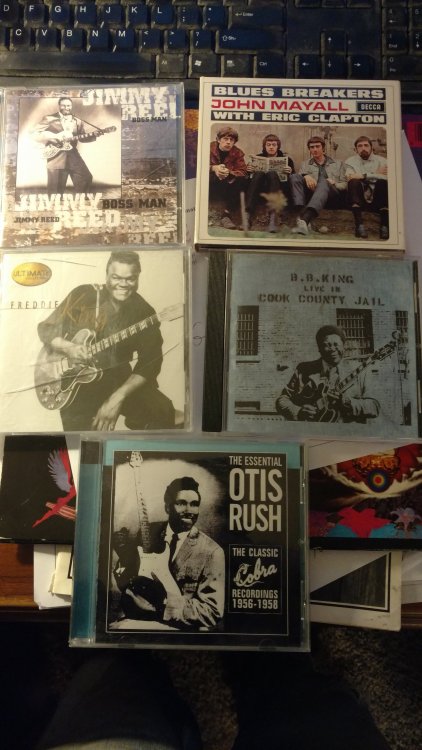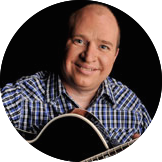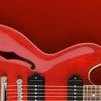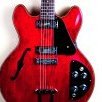
Triple-o
-
Posts
593 -
Joined
-
Last visited
-
Days Won
32
Content Type
Profiles
Forums
Gallery
Events
Articles
Blogs
Downloads
Community Map
Posts posted by Triple-o
-
-
Shuffle in E p.21.
When I got to the 5 chord I found it to be challenging. Some might find it impossible.Thanks to Jimmy Reed I no longer feel the need to make this uncomfortable stretch. I just look at the chord tones B F# D# and the parallel Em/E major pentatonic scales and play whatever I want in that measure.You could also change that B to B7 and use the open A string as the flat 7th (Jimmy did that) which opens up other possibilities.The last measure or turnaround looks like a modulation to the key of F.The author (Rubin) states “historical research” points to the boogie woogie on guitar before the piano. Other “historical research” points to the piano and the creation of the “cut boogie” might also point to the piano. So,take your pick.😎
https://www.youtube.com/watch?v=OfWc52smNs8
-
Ever wonder who played guitar on a hundred or more movies and albums? Just might have been Vic.
-
On 12/7/2021 at 1:24 PM, matonanjin said:
@Triple-o I'm sure you don't remember. A few years ago I posted on here about taking a lesson with a Chicago Blues guy, Paul Kaye. Since it was just a vacation trip to Chicago I couldn't schedule ongoing lessons with Mr. Kaye. He left me with the advice that if I wanted to study the blues and have any success playing it I had to study the old blues masters. Accordingly he left me with a list of albums I should study. This pile are the albums. I hope you can see the Jimmy Reed one in the pile.
Yeah, I remember you talking about Chicago a few years ago. Reed definitely has a different way of playing the 12 bar blues. I didn’t realize the boogie Woogie had its roots in the piano.
-
Here is some material that you can add to “Hal Leonard’s Blues Guitar” by Greg Koch. Sweet Home Chicago lesson.
https://www.musicnotes.com/sheetmusic/mtd.asp?ppn=MN0087716
https://www.musicnotes.com/sheetmusic/mtd.asp?ppn=MN0211217
https://www.youtube.com/watch?v=jwcLnuuDVNI -
On 12/5/2021 at 12:57 PM, Strings said:
I am just learning more about trills and mordants along my journey. Thanks
Have you come across a “Turn”? The turn builds from a mordant.
-
-
“Hoochie Coochie Man” by Muddy Waters would be a good example of stop time.
-
I kept running across this name, so I finally thought I’d look him up.
https://www.youtube.com/watch?v=JveYg57Brxc
https://www.youtube.com/watch?v=J5o6t4fNDi4
-
 1
1
-
-
I agree with this guy on loopers.
https://www.youtube.com/watch?v=t0E7rcIL-q4
https://www.musicnotes.com/sheetmusic/mtd.asp?ppn=MN0146166
-
-
-
-
F A D G B E
I see a few songs in this tuning, usually with a capo. The following song by Coldplay makes sense if you want F in the base. I don’t see much use for using it. What am I missing.
I have also seen it tuned down one step Eb G C F A D like in Sam Smith song “Stay With Me” I guess in this case Sam Smith in needs an asterisk. * Tom Petty and Jeff Lynne.
-
-
-
-
Kinda surprised Steve didn’t include the 4th string F chord with and without the first string mini barre One of the principal chords in C major, C, F and G7 and because of its use in Carter style picking.
-
IToo bad Steve didn’t ditch the band and backing tracks and break out the looper. Working with us on making your own backing tracks would have been a nice touch.
https://acousticguitar.com/a-guide-to-loopers-and-how-to-use-them/
-
It looks like the D’Addario packs are twice the cost of Boveda packs. I am assuming they are both basically the same. Any thoughts?
-
I was curious what guitar made the sound in the Beatles song. Turns out it was a Sitar.
The name is still a puzzler. They said they can’t name the song “ A Cheap Wood”and the first wood that meets that description is Norway Pine..Norwegian wood would be like calling a “Canada goose” a Canadian goose.They were supposedly in Swiss ski lodge with cheap wood paneling. Noway Pine is a cheap wood , but it’s grown in North America, nothing to do with Norway. Another wood could be Norway Spruce, most commonly used as a Christmas Tree,but again no real connection to Norway. Why a Swiss ski lodge in the Alps wouldn’t be using Swiss Pine which isn’t a cheap looking wood ( I think they must mean cheap looking because it blotches easy when being finished) kinda surprises me.
Would love to have a music room or bedroom lined with Swiss Pine.
-
Too bad he doesn’t have a site like Active Melody. I see he sells a course, but only a download.
-
In the key of Dm you have 3 principle chords Dm, Gm and A7. The Gm and A7 are probably the first 4th and 3rd string “barre chords” many folks learn if they are using Mel Bay. Well that’s probably a little misleading,since most beginners never stick with it long enough to make it to grade 2. Steve seemed to skip this “Open” Gm, probably because it requires the thumb. When forming the Gm I personally find using the ring finger easier than using the index.The index is find with the A7.
-
At first I thought this forum format for Guitar Gathering was temporary and “Learn and Master Guitar” would be phased out and Steve would have something completely new. Guitar Gathering is reaching 5 years and number of beginners using the learn and master guitar courses and this forum have dwindled. Perhaps that’s why the Learn and Master course sections 1-20 sessions have been left dangling in a confusing format.
-
Here’s a song that could fit into session 5. It will also introduce you to the capo.







Lesson #91
in Learn & Master Blues Guitar
Posted
“Pedaling lesson” in 100 blues lessons. The authors, I am guessing it’s John that’s writing about listening to players like George Benson and trying to figure out his technique for getting certain sounds. I’ve listened to George Benson play and with out SEEING his right hand there is no way I could tell when he was “pedaling a note alongside a riff” or just playing arpeggios. John and Chad obviously have spend a lot more time on “ear training” than me.
John and Chad both appear to be accomplished teachers and guitar players. I wish the book had a instructional DVD instead of the just the CD.